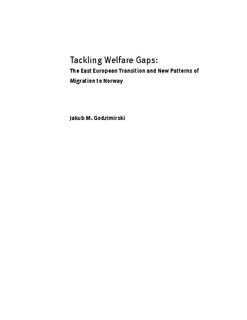| dc.contributor.author | Godzimirski, Jakub M. | |
| dc.date.accessioned | 2016-06-20T14:46:09Z | |
| dc.date.accessioned | 2016-06-22T10:02:18Z | |
| dc.date.available | 2016-06-20T14:46:09Z | |
| dc.date.available | 2016-06-22T10:02:18Z | |
| dc.date.issued | 2005 | |
| dc.identifier.citation | NUPI-rapport nr. 284. Nupi, 2005 | nb_NO |
| dc.identifier.isbn | 82-7002107-5 | |
| dc.identifier.uri | http://hdl.handle.net/11250/2393616 | |
| dc.description | - | nb_NO |
| dc.description.abstract | The main purpose of the study is to analyse how the growing welfare gaps between Eastern and Western Europe have become a securitised issue that needs to be addressed by national, international and supranational bodies. The very existence of welfare gaps is an important migratory push-factor.
This study will examine how the economic and social transition in Eastern Europe – first of all in Russia and Poland, but also in the rest of what used to be defined as Eastern Bloc1 – has contributed to the emergence of a new set
of push and pull factors in the region, and as a direct result, to new patterns of emigration. The next step will be to see how these emerging migratory patterns have influenced migration trends in Norway. As Norway is often represented as the wealthiest country in Europe and a country that has successfully pursued what is often in the Central and Eastern European discourse described as ‘the third way’ of development: a country that, thanks to its revenues from oil, has managed to build a capitalism with a human face,
Norway has become both a potential and actual country of migration to many of the citizens from the former Communist Bloc. Thus, this study maps both the ‘push factors’ in the area of actual and potential emigration in Eastern and Central Europe, as well as the most important ‘pull factors’ in the areas of actual and potential migration, with a focus
on Central/Eastern Europe on the one hand, and Norway on the other. In this context we will look at various institutional and non-institutional strategies of eliminating the welfare gaps perceived as a major cause of migration. As
migration is increasingly becoming a securitised issue, I will treat the ‘welfare gap/migration issue’ as a part of a new post-Cold War European security equation. | nb_NO |
| dc.language.iso | eng | nb_NO |
| dc.publisher | NUPI | nb_NO |
| dc.relation.ispartofseries | NUPI Rapport;284 | |
| dc.rights | Navngivelse-Ikkekommersiell-DelPåSammeVilkår 3.0 Norge | * |
| dc.rights.uri | http://creativecommons.org/licenses/by-nc-sa/3.0/no/ | * |
| dc.title | Tackling Welfare Gaps:The East European Transition and New Patterns of Migration to Norway | nb_NO |
| dc.type | Research report | nb_NO |
| dc.date.updated | 2016-06-20T14:46:09Z | |
| dc.source.pagenumber | 149 p. | nb_NO |
| dc.identifier.cristin | 1362657 | |
| dc.subject.keyword | Europa / Europe | |
| dc.subject.keyword | Internasjonal økonomi / International economics | |

